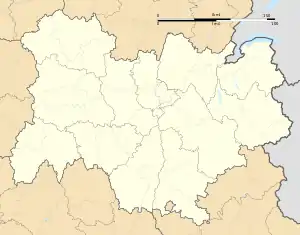Nantua
Nantua (French pronunciation: [nɑ̃tɥa] ⓘ; Arpitan: Nantuat) is a commune in and subprefecture of the Ain département in the Auvergne-Rhône-Alpes region in Eastern France. In 2019, it had a population of 3,454. The commune of Nantua comprises the glacial Lac de Nantua.
Nantua
| |
|---|---|
Subprefecture and commune | |
 A view of Nantua | |
.svg.png.webp) Coat of arms | |
Location of Nantua | |
 Nantua  Nantua | |
| Coordinates: 46°09′07″N 5°36′28″E | |
| Country | France |
| Region | Auvergne-Rhône-Alpes |
| Department | Ain |
| Arrondissement | Nantua |
| Canton | Nantua |
| Intercommunality | Haut-Bugey Agglomération |
| Government | |
| • Mayor (2020–2026) | Jean-Pascal Thomasset[1] (DVD) |
| Area 1 | 12.79 km2 (4.94 sq mi) |
| Population | 3,453 |
| • Density | 270/km2 (700/sq mi) |
| Time zone | UTC+01:00 (CET) |
| • Summer (DST) | UTC+02:00 (CEST) |
| INSEE/Postal code | 01269 /01130 |
| 1 French Land Register data, which excludes lakes, ponds, glaciers > 1 km2 (0.386 sq mi or 247 acres) and river estuaries. | |
Located in the Haut-Bugey historical region, among the southern foothills of the Jura Mountains, it is famous for its fresh-water fish and crayfish.[3]
History
The town grew up around a Benedictine monastery founded in 671 by Amandus and the church of St Peter where the body of Charles the Bald was initially buried.
The priory of Nantua was sacked and burned in 1230 by Stephen I of Thoire-Villars.[4] Boniface of Savoy was selected prior in 1232.[4]
In 1944, a hundred men were arrested and deported and the local French Secret Army leader was shot dead by the Nazis in response to French resistance activities.[5]
Demographics
| Year | Pop. | ±% p.a. |
|---|---|---|
| 1968 | 3,560 | — |
| 1975 | 3,440 | −0.49% |
| 1982 | 3,572 | +0.54% |
| 1990 | 3,602 | +0.10% |
| 1999 | 3,902 | +0.89% |
| 2007 | 3,663 | −0.79% |
| 2012 | 3,588 | −0.41% |
| 2017 | 3,446 | −0.80% |
| Source: INSEE[6] | ||
Climate
Nantua faces the small Lac de Nantua on its west side and is protected by high cliffs on its landward sides which gives rise to a relatively mild continental climate.
References
- "Répertoire national des élus: les maires" (in French). data.gouv.fr, Plateforme ouverte des données publiques françaises. 13 September 2022.
- "Populations légales 2020". The National Institute of Statistics and Economic Studies. 29 December 2022.
- Waverley Root, The Food of France, p. 215
- Eugene L. Cox, The Eagles of Savoy, (Princeton University Press, 1974), 17-18.
- Matthew Cobbs, The Resistance, p. 181
- Population en historique depuis 1968, INSEE
External links
- Town council website (in French)
- Tourism office website (in French)